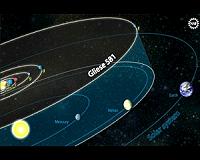 |
South Bend IN (SPX) May 23, 2011 University of Notre Dame astronomer David Bennett is co-author of a new paper describing the discovery of a new class of planets - dark, isolated Jupiter-mass bodies floating alone in space, far from any host star. Bennett and the team of astronomers involved in the discovery believe that the planets were most likely ejected from developing planetary systems. The study is described in a paper appearing in the journal Nature. The discovery stems from an analysis of observations of the central bulge of the Milky Way galaxy taken in 2006 and 2007 by a joint Japan-New Zealand survey. This analysis provides evidence of what appear to be 10 free-floating planets roughly the mass of Jupiter. Bennett explains the likely origin of these isolated planets, "Our results suggest that planetary systems often become unstable, with planets being kicked out from their places of birth by close encounters with other planets". This discovery not only confirms that free-floating planets exist in space, but also indicates that they are quite common. Free-floating planets are very hard to detect, so the fact that the survey found up to 10 implies that there are many more that are not detected. The team of scientists that made the discovery estimates that there are about twice as many free-floating Jupiter-mass planets as stars. This implies that free-floating planets are likely to be least as common as planets, like ours, that orbit stars. "Our survey is like a population census - we sampled a portion of the galaxy and, based on these data, can estimate overall numbers in the galaxy," Bennett said. "The survey is not sensitive to planets less massive than Jupiter and Saturn, but theories suggest that lower-mass planets like Earth should be ejected from their stars more often and are thus more common that free-floating Jupiters." Some scientists have even suggested that free-floating Earth-mass planets could be warm enough to host life, due to the greenhouse effect of a large amount of Hydrogen in their atmospheres. NASA's planned WFIRST mission will use the microlensing method to reveal how many free-floating Earth-mass planets inhabit the Milky Way galaxy. The survey that revealed the planets is called the Microlensing Observations in Astrophysics (MOA). A 1.8-meter (5.9-foot) telescope at Mt. John University Observatory in New Zealand is used to regularly scan the stars at the center of the Milky Way galaxy for what are referred to as "gravitational microlensing events." Bennett is a pioneer in the gravitational microlensing method, which takes advantage of the fact that light is bent as the rays pass close to a massive object, like a star. The gravity from the mass of the foreground planet warps surrounding space and acts like a giant magnifying glass. As predicted by Albert Einstein and later confirmed, this phenomena causes an apparent brightening of the light from a background "source" star. The effect is seen only if the astronomer's telescope lies in almost perfect alignment with the source star and the lens star. The primary challenge of the microlensing method is the precise alignments needed for the planetary microlensing signals are quite rare and brief, lasting less than two days. Astronomers are also able to detect planets orbiting stars if the light from the background star is warped by both the planet and its host star. Bennett and the team of scientists found about 10 short microlensing events, indicating planets of roughly Jupiter's mass. The team said that it can't rule out the possibility that some of the planets may be in very distant orbits about stars, but previous observations by other groups suggests that Jupiter-mass planets in such distant orbits are rare. Future observations by the Hubble Space Telescope should detect many of these host stars, if they exist. "If free-floating planets formed like stars, then we would have expected to see only one or two of them in our survey instead of 10," Bennett said. A second microlensing survey group, the Optical Lensing Experiment (OGLE) also contributed to the discovery reported in Nature. The OGLE group observed many of the same microlensing events observed by MOA and these observations indecently confirmed MOA's analysis.
Share This Article With Planet Earth
Related Links University of Notre Dame Lands Beyond Beyond - extra solar planets - news and science Life Beyond Earth
 Climate scientists reveal new candidate for first habitable exoplanet
Climate scientists reveal new candidate for first habitable exoplanetParis, France (SPX) May 23, 2011 The planetary system around the red dwarf Gliese 581, one of the closest stars to the Sun in the galaxy, has been the subject of several studies aiming to detect the first potentially habitable exoplanet. Two candidates have already been discarded, but a third planet, Gliese 581d, can be considered the first confirmed exoplanet that could support Earth-like life. This is the conclusion of ... read more |
|
| The content herein, unless otherwise known to be public domain, are Copyright 1995-2010 - SpaceDaily. AFP and UPI Wire Stories are copyright Agence France-Presse and United Press International. ESA Portal Reports are copyright European Space Agency. All NASA sourced material is public domain. Additional copyrights may apply in whole or part to other bona fide parties. Advertising does not imply endorsement,agreement or approval of any opinions, statements or information provided by SpaceDaily on any Web page published or hosted by SpaceDaily. Privacy Statement |